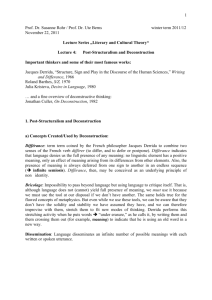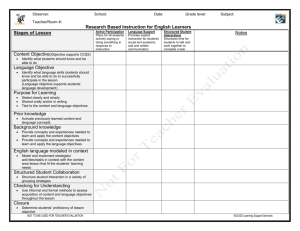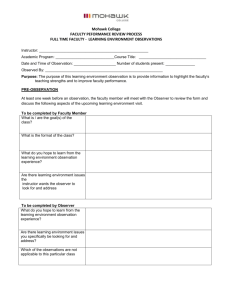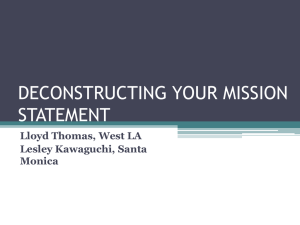Luhmann - Iowa State University
advertisement
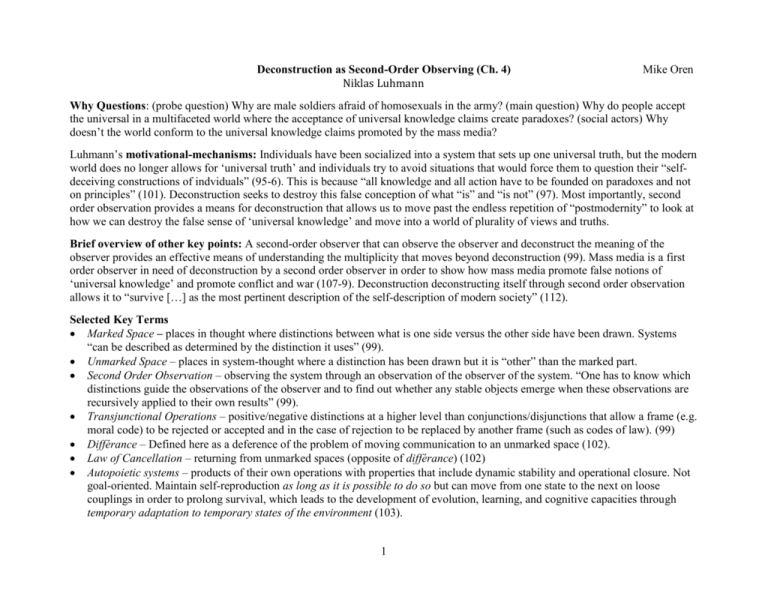
Deconstruction as Second-Order Observing (Ch. 4) Niklas Luhmann Mike Oren Why Questions: (probe question) Why are male soldiers afraid of homosexuals in the army? (main question) Why do people accept the universal in a multifaceted world where the acceptance of universal knowledge claims create paradoxes? (social actors) Why doesn’t the world conform to the universal knowledge claims promoted by the mass media? Luhmann’s motivational-mechanisms: Individuals have been socialized into a system that sets up one universal truth, but the modern world does no longer allows for ‘universal truth’ and individuals try to avoid situations that would force them to question their “selfdeceiving constructions of indviduals” (95-6). This is because “all knowledge and all action have to be founded on paradoxes and not on principles” (101). Deconstruction seeks to destroy this false conception of what “is” and “is not” (97). Most importantly, second order observation provides a means for deconstruction that allows us to move past the endless repetition of “postmodernity” to look at how we can destroy the false sense of ‘universal knowledge’ and move into a world of plurality of views and truths. Brief overview of other key points: A second-order observer that can observe the observer and deconstruct the meaning of the observer provides an effective means of understanding the multiplicity that moves beyond deconstruction (99). Mass media is a first order observer in need of deconstruction by a second order observer in order to show how mass media promote false notions of ‘universal knowledge’ and promote conflict and war (107-9). Deconstruction deconstructing itself through second order observation allows it to “survive […] as the most pertinent description of the self-description of modern society” (112). Selected Key Terms Marked Space – places in thought where distinctions between what is one side versus the other side have been drawn. Systems “can be described as determined by the distinction it uses” (99). Unmarked Space – places in system-thought where a distinction has been drawn but it is “other” than the marked part. Second Order Observation – observing the system through an observation of the observer of the system. “One has to know which distinctions guide the observations of the observer and to find out whether any stable objects emerge when these observations are recursively applied to their own results” (99). Transjunctional Operations – positive/negative distinctions at a higher level than conjunctions/disjunctions that allow a frame (e.g. moral code) to be rejected or accepted and in the case of rejection to be replaced by another frame (such as codes of law). (99) Différance – Defined here as a deference of the problem of moving communication to an unmarked space (102). Law of Cancellation – returning from unmarked spaces (opposite of différance) (102) Autopoietic systems – products of their own operations with properties that include dynamic stability and operational closure. Not goal-oriented. Maintain self-reproduction as long as it is possible to do so but can move from one state to the next on loose couplings in order to prolong survival, which leads to the development of evolution, learning, and cognitive capacities through temporary adaptation to temporary states of the environment (103). 1 Luhmann’s History of Modern Knowledge Universal Knowledge is Shattered (Postmodern world begins) -> Postmodern (Endless repeat) -> Derrida & Deconstruction( Questions Remain) -> Mass Media (Fills the gap) -> Second Order Observation (Realization of Deconstruction) = End of History Transition from Deconstruction to Second-Order Observation (101-104) 1. Observations are asymmetric -> 2. One tries to observe both sides and paradoxes are created -> 3. Problems are deferred (différance) -> 4. Using from (=distinction) transition from temporalization to looking at anit-temporal events of autopoietic systems form as products of their own operations -> 5. Selfobservation where the system observes the system can occur allowing for reentry (of the difference into itself) Second Order Observation System (not individuals, but social systems) <- Observers (each observer chooses the system to observe in the way they choose to observe it) <- Second Order Observer (make a decision to observe one observer over another and deconstructs the observations of the observer) Who watches the Watchmen? The Second Order Observers. Eigenfaces (left) are an application of the concepts of eigenvalues, they are a combination of multiple human faces that have been normalized and aligned, using an eigenface one can then use this for facial recognition to see if an individual is in the database (eigenface) that you want to track or grant access to. So multiple faces become one face that then references itself (as in the face that it is composed of). Semi-relevant (popular media / non-academic): Guardian UK wrote a piece on Bernard d'Espagnat, a physicist that believes reality is simply our construction of it and does not match a ‘true reality’—he is one of the pioneers of quantum physics working to change our conception of what we thought was ‘truth’ through experimental proof in physics: http://www.guardian.co.uk/science/blog/2009/mar/17/templeton-quantum-entanglement 2

